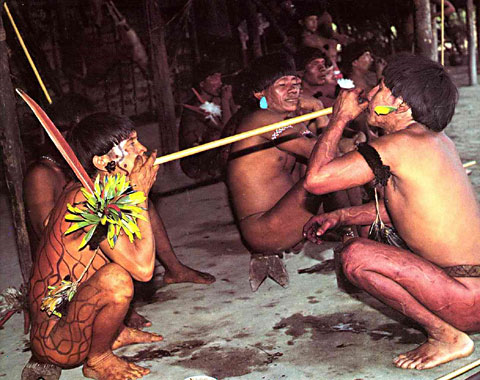
The Yanomami are jungle Indians living in the Amazon; these people are referred to as the most primitive communities ever existed. It is necessary to underline the idea that the Yanomami tribes have always been centralized in anthropological researches and studies, through their cultural environment, norms, and traditions. These Indians managed to live in complete harmony with nature and reach superior balance and welfare, but for internal interactions on the part of civilized nationalities. The Yanomami of Brazil and Venezuela can be considered the arena of aggression and conflict in Amazon; this interaction resulted in the global tragedy taking the lives of the whole communities.
Yanomami’s culture is focused on the development of agriculture and hunting; the era of globalization and technological dominance never touched this population, who live by the rules of nature. Metal and wheel are considered to be referred to as the innovations for this Amazon population. It should be noted that the Yanomami live in separate local groups concentrated in collective villages; communities’ relationships are based on mutual political, economical and ceremonial exchange. (Ushinahua, n.d.)
In 1987 the Yanomami suffered an invasion by illegal gold miners which brought destruction to their cultural unity and several deaths among the population. Even though the Yanomami are considered to be the largest isolated tribe, their territory and people’s lives were under the threat. About 40000 invaders attacked the territory of Indian tribes with the purpose of gold mining. Davi Yanomami states, ‘The biggest problem for the Yanomami now is the garimpeiro (gold miners) who are in our land, and the illness they bring with them. Among them, some have illnesses like flu, tuberculosis, and venereal diseases, and contaminate my people’. (Chatterjee, 1997) And it was the greatest problem leading to genocide and numerous deaths; it is necessary to underline the fact that the health problem was beyond the control of the Brazilian government and resulted in a real tragedy. The epidemics of malaria, as well as other diseases, appeared to be the start of a rapid decrease of the Yanomami population. The gold miners managed to create the crisis in 1992, though soon the territory was protected by the federal indigenous reserve provided by the Brazilian government. The start of the ‘Haximu Massacre’ in 1993 was caused by golminers’ dissatisfaction with reserve creation and their desire to exterminate the tribe village. The murder of sixteen Yanomami by the miners appeared to be called genocide. It should be noted that in 2006 the gold miners were sentenced to 19 years of imprisonment by the Supreme Federal Court of Brazil. Despite this fact, nowadays the territory of Yanomami is under political pressure because of commercial mining operations reducing the tribe’s land.
The case of genocide has been thoroughly studied by the field of anthropology and politics; by UN convection, the intention to destroy national, ethnic, or racial groups is considered to be genocide. Goldminers, working illegally on the territory of Yanomami, shot women, children, and old people, intending to show their power and right to their land.
The problem of international conflict is based on the mass promotion of serious and lethal viruses causing a decrease in the Yanomami population number. Toxicant materials brought by gold miners were spread into the water, air, and land of the tribes; as a result, human beings suffer cardiac pain, decreased thyroid functions, and the toxicity of the central nervous system. According to the Health Care Center researches, about 15% of the Yanomami have been affected and died because of promoted diseases. It should be noted that the National Health Foundation identified about 175 deaths caused by malaria spreading. Many contemporary diseases have not been officially registered in the Yanomami territory before the invasion; only the invasion of illegal gold miners appeared to be the reason for mass deaths connected with this illness. It is necessary to underline the fact that the Brazilian government developed a health project aimed at malaria eradication; nevertheless, this problem is still unsolved for the population.
In 2005, the Yanomami Indians invaded the National Health Foundation, expressing their protest to the government because of insufficient problem solutions. Indigenous leaders participating in protest meetings demonstrated their concern as to the health care ignorance for the Yanomami people, ‘In all the history of indigenous health, we have never seen such suffering provoked by the total negligence of the government and health authorities. (Yanomami invade National Health Foundation as health deteriorates rapidly. 2005)
One should note that the problem is still open to discussion; the Yanomami are against the development of the mining industry within their territory stating that this step would never be beneficial for their people. The gold miners happed to bring grave health problems to the tribe, rather than industrial progress. The spreading of diseases in the Amazon provides a threat to the life of the whole ethnical group killing hundred of people annually; the gold appeared to be the principal cause for tuberculosis, malaria, and influenza outbreak. The local government is to develop and take serious measures to tackle the global cultural and national problems.
References
- Chatterjee, P. (1997). Gold, Greed and Genocide in the Americas: California to the Amazon.
- Ushinahua, Ch. (n.d.) Yanomami Indians: The Fierce People? Web.
- Yanomami invade National Health Foundation as health deteriorates rapidly. (2005). Survival. Web.